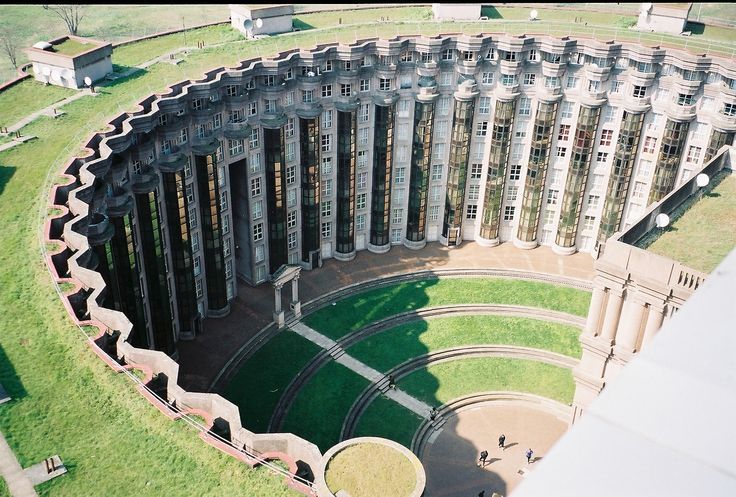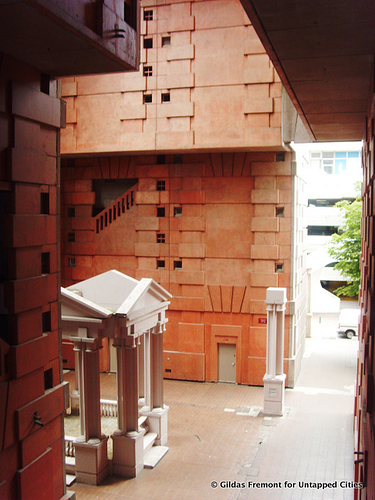related old SB pointed me at How Buildings Learn and it’s stuck with me regarding designing projects with change in mind.
There were some fascinating places built in the 70s and 80s as an absolute repudiation that nice architecture, with an understanding of history is incompatible with affordable housing. Young architects obviously hated the ‘functional’ architecture of Sarcelles
and one of my favorite responses to this soul-deadening modernism was the Abraxas Spaces:
It demonstrates that there are still possibilities even with the confines of pre-fabrication to make something spirited, unusual and visually striking.
Les Espaces d’Abraxas looks really neat. I’d love to visit it some day.
I don’t think we’re fundamentally disagreeing here – maybe just on how far some factors can be attributed to post-war construction? I agree that the factors at play which resulted in Modernist/post-WW2 architecture were complex, but quickly constructed and attractive buildings were not some sort of foreign technology or idea (this is part of what I mean about Modernism’s anti-historical bent; when older principles for widely successful civic design could have been consulted, a lot of architects opted for a hastened reinvention of symbolism, form, and urban planning). Also, I think we would’ve seen a more significant difference between post-WW2 buildings in America compared to those in, say, England if devastation of the human-made landscape had an inextricable relationship with the imagination and empathy evident in the relevant architectural projects. In either case, I think the circumstances of either country – America with its wealth and highways and European countries, in the wake of an enormous cultural loss, waiting for wide-scale restoration – allowed for a degree of egotistical and unrealistically theoretical exploitation by architects (compare the Pruitt-Igoe complex to the Robin Hood Gardens, for example; also note how both sites were witness to destructive behaviors by the occupants which can be interpreted, even if the occupants themselves were not conscious of the reasons for their aggression, partially as responses to being treated inhumanely).
This is great. Thanks for sharing it. Reminds me that I need to read Christopher Alexander’s stuff.
[quote=“diplo, post:66, topic:948, full:true”]
Les Espaces d’Abraxas looks really neat. I’d love to visit it some day.[/quote]
Yeah, thanks for bringing that up, haven’t seen this before … guess I’ll be going on an internet-field day for the next few hours!
OK, now I see where you are coming from - yeah, the hastened aspect that you mention has been completely
below the radar for me until now. I want to read up on that, thanks for bringing it up (also will be looking up that Pruitt-Igoe/Robin Hood Gardens you’ve mentioned).
Meanwhile . . .
When completed, this 61-story tower, on an important site between Christian Science Plaza and the Prudential Center in Boston’s Back Bay, will be the city’s tallest residential building. A 211-room hotel will occupy the tower’s lower eighteen floors, with 188 luxury condominiums on thirty-six floors above.
This is a part of the article I’m writing to give historical context. That drawing, and other material like it, is a part of a theoretical and practical concern with the dematerialization of structure. I think you could categorize it as one of the many manifestations of rationalism as a western philosophical phenomenon. Friedrich Gilly, a German, was responsible for that drawing, but I’d say, if you want to get regional, it’s more indebted to French thought that reaches as far back as the 17th century with the projects and writings of people like Claude Perrault, and texts that are more explicit about architecture’s “functional language”, like that of Jean-Louis de Cordemoy’s. So probably the easiest way of answering your question is by saying that the style in the drawing comes from a concern for “authenticity”, “purity”, and “timelessness” expressed through a building’s form and construction (we’d see the worst and most dogmatic assertion of this concern in Adolf Loos’ “Ornament and Crime”, among other things in the 20th century).
just noticed this now:
picture 5 looks bizarre … that skyscraper overshadowing anything around it looks slightly out of place there.
That’s the John Hancock tower. I don’t like it at all.
Since this is the architecture thread I’m going to post this here
http://www.theguardian.com/artanddesign/2015/mar/01/african-modernist-architecture
Because those are for sure some cool buildings
Those open designs make a lot more sense in the climate, as well. That’s one of the features of classical architecture that I would have thought obvious, but apparently was not, when it was imported to All Official Buildings of the US: it’s Mediterranean. Colonnades don’t work so well when bitterly cold wind is blowing snow between them.
Oh. I was excited for a second when I thought it was about African architects.
P.S.
![]()
Have to say, as much as I take issue with brutalist architecture for reasons like its hypermasculine points of origin and its interest in novel exterior shapes over its internal realities, all of the shit boring buildings that’ve been popping up in Boston are making me appreciate it more just in terms of visual relativity.
Here’s a building I pretty much hate but which makes for some neat photos.
Brutalist buildings are great for photography, yeah. There’s an Instagram account I follow that posts lots of user submitted photos of brutalist structures. A quick google search turned up the corresponding Tumblr account:
Sweet.
I… I think Brutalism looks neat.
I’ll show myself out.
I think some brutalism looks neat. I just don’t think it’s appropriate in most circumstances.
Boston City Hall, for example.
As a sculpture, inside and out, there’s a lot to admire. As a building, its fortress-like qualities suggest that its main purpose is to keep people out than to the symbolically, or actually, involve them in their local government. The repetitive and dark fenestration on the upper levels look like the innumerable eyes of some alien overlord, while the massive, varied, and overlapping forms below suggest that to even reach this level of governance one must contend with an impractical and confusing variety of hurdles. That is maybe the actual state of the relationship between the city government and the public, but I think a city hall should at least make the gesture of invitation.
But the plaza is a lot worse. I’d rather the city reworked that than the building. It’s an urban wasteland that does not encourage (or really even allow) congregating at all. Seemingly another case of “doesn’t this look neat as a drawing” vs. “okay this really doesn’t work when implemented in real life.” Even in that photo you can see how people are sitting around a couple of delineated elevations, while the majority of the space goes unused.
Hey that’s Freeway Park in Seattle! One of the most visually interesting parks, and it’s a great approach to Brutalism: attempted mergers of natural and artificial shapes. Brutalism works best in that context (also see Evergreen State College’s main campus, where it is just abstract shapes overgrown with nature (nb all the new buildings are hideous))
I would explore and jump around that park.

















